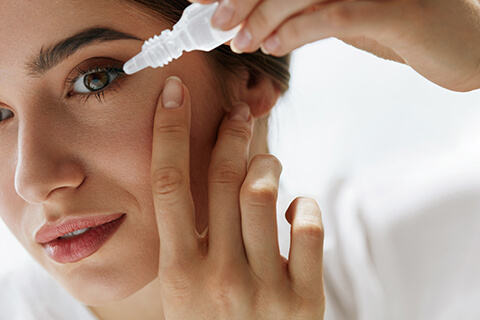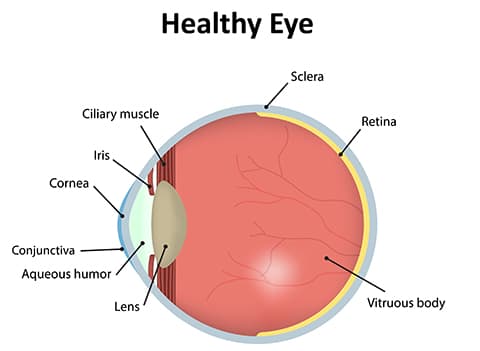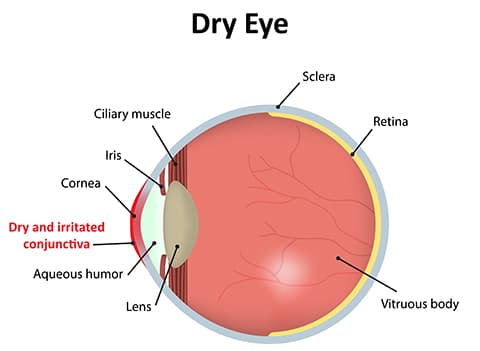Dry Eye

Dry eye syndrome is one of the most common problems treated by eye physicians. Over ten million Americans suffer from dry eyes. It is usually caused by a problem with the quality of the tear film that lubricates the eyes.
Tears are comprised of three layers. The mucus layer coats the cornea, the eye’s clear outer window, forming a foundation so the tear film can adhere to the eye.
The middle aqueous layer provides moisture and supplies oxygen and other important nutrients to the cornea. This layer is made of 98 percent water along with small amounts of salt, proteins, and other compounds. The outer lipid layer is an oily film that seals the tear film on the eye and helps to prevent evaporation.
Tears are formed in several glands around the eye. The water layer is produced in the lacrimal gland, located under the upper eyelid. Several smaller glands in the lids make the oil and mucus layers. With each blink, the eyelids spread the tears over the eye. Excess tears flow into two tiny drainage ducts in the corner of the eye by the nose. These ducts lead to tiny canals that connect to the nasal passage. The connection between the tear ducts and the nasal passage is the reason that crying causes a runny nose.
In addition to lubricating the eye, tears are also produced as a reflex response to outside stimuli such as an injury or emotion. However, reflex tears do little to soothe a dry eye, which is why someone with watery eyes may still complain of irritation.
Dry eye syndrome has many causes. One of the most common reasons for dryness is simply the normal aging process. As we grow older, our bodies produce less oil – 60% less at age 65 than at age 18. This is more pronounced in women, who tend to have drier skin then men. Oil deficiency also affects the tear film. Without as much oil to seal the watery layer, the tear film evaporates much faster, leaving dry areas on the cornea.


Many other factors, such as hot, dry, or windy climates, high altitudes, air-conditioning, and cigarette smoke also cause dry eyes. Many people also find their eyes become irritated when reading or working on a computer. Stopping periodically to rest and blink keeps the eyes more comfortable.
Contact lens wearers may also suffer from dryness because the contacts absorb the tear film, causing proteins to form on the surface of the lens. Certain medications, thyroid conditions, vitamin A deficiency, and diseases such as Parkinson’s and Sjogren’s can also cause dryness.
Women frequently experience problems with dry eyes as they enter menopause because of hormonal changes.
Symptoms
- Itching
- Burning
- Irritation
- Redness
- Blurred vision that improves with blinking
- Excessive tearing
- Increased discomfort after periods of reading, watching TV, or working on a computer
Treatment
Dry eye treatment usually begins with lubricating the surface of the eye. Eyedrops known as Artificial Tears are easy to find in any pharmacy. They come in different thicknesses, so you may have to experiment to find the right one. Some drops contain preservatives that might irritate your eyes. Drops without preservatives don’t usually bother the eyes but maybe less convenient to use.
At night, an eye ointment might provide more relief. Ointments are thicker than artificial tears and moisturize and protect the eye for several hours. They may blur your vision, which is why some people prefer to use them while they sleep.
Another alternative is to have a minor procedure to close the tear ducts that drain tears from the eye. The surgery is called punctal occlusion. For a temporary closure, the eye doctor inserts collagen or silicone plugs into the ducts. Collagen plugs eventually dissolve, and silicone plugs are “permanent” until they are removed or fall out. For a longer-lasting effect, the eye doctor can use a laser or cautery to seal the ducts.
Some patients benefit from an eyedrop medication (prescription required) called Restasis. When effective, Restasis promotes tear production and improves the protective quality of the tear film. Additionally, there is evidence that taking omega-3-fatty acids (ie: flaxseed oil) can improve dry eye symptoms.



